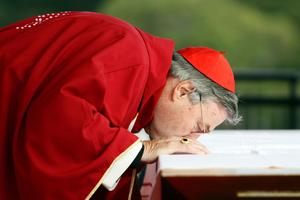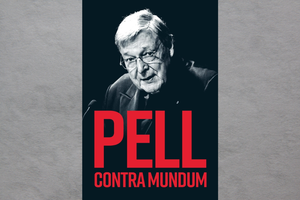7 Years Ago, Cardinal Pell Made History in Canterbury Cathedral
On July 7, 2015, Cardinal George Pell became the first Catholic cardinal since the 16th century to offer Mass at the cathedral’s high altar.

CANTERBURY, England — One of Cardinal George Pell’s lesser-known accomplishments — one laden with historical significance that furthered the cause of Christian unity — took place in Canterbury Cathedral seven years ago.
Visiting the English city famous for its Church history, the Australian cardinal celebrated Mass at the cathedral’s high altar on July 7, 2015, becoming the first Catholic cardinal to do so since Cardinal Reginald Pole, the last Catholic archbishop of Canterbury, in the 16th century.
The date of July 7 commemorated the anniversary of the consecration in 1220 of a shrine dedicated to St. Thomas Becket, the archbishop of Canterbury who was martyred in Canterbury Cathedral in 1170 after a bitter clash with King Henry II over the rights of the Church over the state.
Following his martyrdom and until 1220, St. Thomas’ shrine had been kept in the crypt of the cathedral, drawing tens of thousands of pilgrims a year and bringing many reports of miracles attributed to his intercession.
But in 1220, as the numbers of pilgrims continued to grow, the shrine was transferred to a more prominent place: behind the high altar of the cathedral. There it remained — continuing to draw throngs of pilgrims and inspiring Geoffrey Chaucer’s Canterbury Tales — until 1538, when King Henry VIII had it completely destroyed. Today, nothing but a burning candle remains in the place of the shrine.
The Church of England’s former dean of Canterbury Cathedral, the Very Reverend Robert Willis, who retired last May, told the Register that when he took up his position as dean in 2001, he became aware that two significant dates — Becket’s martyrdom on Dec. 29, and the consecration of the new shrine on July 7 — were held as sacred, and observed as feasts, by the now-Anglican cathedral and the neighboring Catholic Church of St. Thomas alike.
“During my time in Canterbury, Dec. 29 became a time of pilgrimage for many, and the service commemorating the martyrdom during Vespers drew larger and larger numbers over the years at 3 o’clock in the afternoon,” Dr. Willis recalled. “The clergy from the cathedral and St. Thomas’ shared this event, and in the evening, at 8 o’clock, a second Vespers was shared, led by the clergy from St. Thomas’ and attended by the cathedral clergy in the crypt at the site of the original shrine.”
The former dean added that the July 7 commemoration of the consecration of the new shrine behind the high altar is annually marked by a customary procession after choral evensong to the site of the shrine, “and then in the evening a Catholic Mass would be celebrated at the high altar.”
Catholic bishops and priests — including the Catholic archbishop of Southwark, whose archdiocese includes Canterbury — had celebrated Mass there before to mark the occasion. But 2015 “was a special year,” Dr. Willis said, “because Cardinal Pell himself was present in Canterbury and on the evening of 7th July celebrated Mass at the high altar.”
He added that the cardinal, whose father was an Anglican, had already had some connection with the city as he had encouraged annual cricket matches between teams from the Church of England and the Vatican, which were played alternately in Rome and at the cricket ground at Canterbury. The tournament, the idea of Australia’s former ambassador to the Holy See, John McCarthy, involved clergy and seminarians competing for a silver cup bearing the inscription “Ut Unum Sint” (That They May Be One).
Other ecumenical gestures also took place between Canterbury and Rome that year, including a loan to the current archbishop of Canterbury Justin Welby of the ancient ivory head of a crozier associated with Pope St. Gregory the Great, the pope who sent St. Augustine of Canterbury to evangelize the Anglo-Saxon peoples.
In another historic gesture, Archbishop Welby received from Corpus Christi Library in Cambridge the Book of the Gospels that St. Gregory gave Augustine before he left for England. Insured for £50 million and of incalculable worth to Christian patrimony, 2015 was the first time the crozier and the Book of Gospels had been united in more than 1,400 years.
Then, five years later, to commemorate the 850th anniversary of Becket’s death and the 800th anniversary of the new shrine, the Vatican lent to the cathedral the martyr’s bloodstained tunic. The gestures from Rome were spearheaded by Australian Father Robert McCulloch, a Rome-based Columban missionary who spent many years in Pakistan.
“I felt that in the context of ecumenism it was vitally important to show support and encouragement,” Father McCulloch said a few months later.
“These occasions were all steps in fulfillment of Our Lord’s prayer for the unity of his Church,” Reverend Willis told the Register, “and the cardinal’s Mass in 2015 was a physical sign of the Church’s intention to seek that unity.”

















